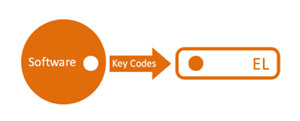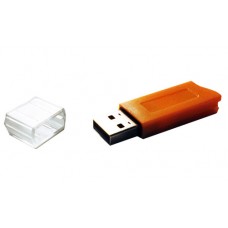Elite EL RTCC Dongle
The Elite EL RTCC provides the same high level of protection as the EL RTC, with the added attribute that its battery can be repeatedly charged/discharged. When not connected to a host computer, the EL RTCC runs on its internal battery, but once connected, it runs on a charge from the host, while at the same time recharging its internal battery.
Features
Sustaining Technology
Having the same techncial apects as the Elite EL RTC, with the added feature of an on-board battery-backed real-time clock that can be repeatedly charged and discharged, the Elite EL RTCC is the state of the art in advanced dongle technology today.
Without any interference to normal operations, the Elite EL RTCC battery can be charged by the host computer. In this way, the EL RTCC has a longer life than most competing products..
The EL RTCC employs internal LDO power-supply management, so when connected with a host computer, the internal power-supply management automatically switches to external power-supply, which charges the battery simultaneously. Insufficient battery power is alerted by a LED light indicator on the dongle.
Independant Real-time Clock
Elite EL RTC is a hybrid of the Elite EL STD dongle and a real-time clock. Its time calculation is done by an internal clock which is battery-driven and sustainable for at least 3 years. Its unique design is to terminate the misuse of licenses through computer clock adjustments.
Best Chip Security
The Elite EL RTCC is designed and manufactured to explicit manufacturing norms (ISO/IEC 10373, ISO/IEC 15408), formulated in accordance with international criteria EAL (Evaluation Assurance Level), and ranked in the international 1-7 grading system for scientific evaluation of chip security. The EAL 5+ chip technology upon which the EL RTC is based, is a known upper security limit for current products; it doesn't get any higher.
Elite EL RTCC is equipped with the most advanced PHILIPS 16-bit smart card chip reaching EAL 5+ in the global hi-tech sector. This furnishes EL with outstanding effectiveness in resistiance to major attacks such as Electronic Attack (SPA and DPA), Probe Attack (SiShell), Chip Dissection and Debug Port.
Code-Port Solution
Code Port is an evolutionary technique of transferring via secure communication, key pieces of executable code to the dongle. When a corresponding dongle is plugged, the protected application invokes specific API functions to run this executable code that has been locked away in the smart chip on the dongle. The code performs operations on data stored in the dongle and returns legal results, so as to complete the full verification operation for the protected application. As the executable code and data stored in the dongle do not have copies on the deployment host PC, malicious crackers cannot get algorithms or data by physical interception. In a word, EL provides the ultimate in reliability to shield software developers from financial loss caused by pirating activities.

Smart Technology
As distinguished from conventional chip technology, the Elite EL smart card chip contains a high performance cryptographic algorithm accelerator or coprocessor. In the chip, the COS (Card Operation System) and its applications are simply running to implement tasks. In other words, this smart card chip can be viewed as a highly integrated mini PC.
Automatic Self-locking Mechanism
Access to the chip is protected by PIN, and the maximum re-tries is pre-set by software developers. For instance, under a dictionary attack, once the number of re-tries exceed the pre-set value, the chip will trigger a self-locking mechanism and block all external running operations.
Global Unique Serial Number
A global unique serial number, which cannot be altered or rewritten, is assigned to the EL smart card chip. This puts an end to the piracy and enables the effective management of released chips. Furthermore, when using Senselock EL dongles, software developers are assigned a unique Client ID, which in effect addresses the critical issue of fraudulent dongle reproduction.
Built-in Timer
A dongle on-board timer is a useful component for software protection that applies to time-limited usage and anti-tracking. EL has a built-in timer lasting more than 10 hours, longer than most competing products on the market today.
Operating Systems Supported
Window 98SE/ME, Windows 2000, Windows XP, Windows Vista, Windows 7, Windows Server 2003, Windows Server 2008, Windows 8, Windows 10, Linux, MacOS.
Programming Languages Supported
VC++, C++ Builder, BC, VC6, VS2005, VS2008, Delphi6, Delphi7, Delphi2010, VB6, VB2008, PB, AutoCAD, C#, Java and more.
| Power | |
| Working Voltage | DC 5V +/- 5% |
| Max Consumption | 100mW |
| Environment | |
| Working Temperature | -25℃ ~ 85℃ |
| Memory | |
| Data Retention | 10 years |
| Write Cycles | 500,000 (minimum) |
| RAM (bytes) | 254+2047 (VM Mode) |
| Memory (bytes) | 64K |
| IO Buffer (bytes) | 250 |
| Connectivity | |
| Connection Type | USB 1.1 full speed, USB 2.0 |
| Connection | Driver or HID |
| Encryption | |
| Encryption Algorithm | RSA, DES, TDES, SHA1 |
| CPU | |
| Chip | 32-bit, 16MHz Smartcard |

